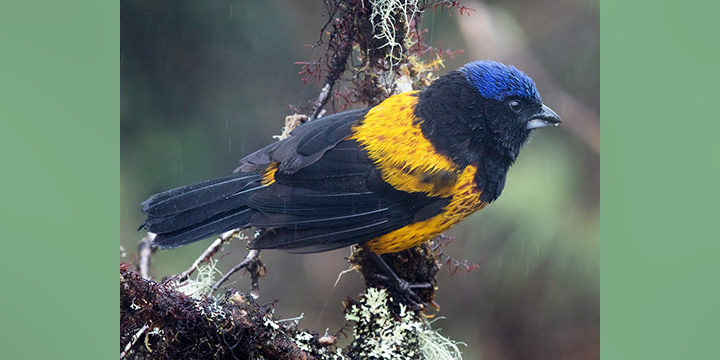Bird of The Week: Golden-backed Mountain-tanager
Scientific Name: Cnemathraupis aureodorsalis
Population: 250-2,500
IUCN Status: Endangered
Trend: Decreasing
Habitat: High-elevation elfin forest and shrubs near treeline
About the Golden-backed Mountain-tanager
The size of an American Robin, the Golden-backed Mountain-tanager is one of the largest tanager species. It’s also one of the least known. Like the Seven-colored Tanager and Green-headed Tanager, this species has a restricted range. Unlike those lowland species, though, it lives at lofty heights near the edge of where trees can grow — in misty, stunted (or elfin) forest along the Peruvian Andes’ eastern slope.
“Spectacular.” That’s how ornithologists Robert S. Ridgely and Guy Tudor began their short description of this bird in their Field Guide to Songbirds of South America. Of eleven mountain-tanager species, only this one has a bright yellow-orange back and rump, as well as chestnut streaks (on its underparts and, more subtly, on its back). Considered Endangered, the Golden-backed Mountain-tanager’s total population is estimated at between 250 and 2,500 adults.
Murky Numbers
The Golden-backed Mountain-tanager occurs mostly in remote, sparsely populated areas. This may be to its advantage, but no one can be sure about its distribution or true numbers because few people have seen this bird outside of a few known areas. The best conservationists can do is estimate the best and worst scenarios for its population size, based on potential habitat. Much survey work will be required to fully understand this species’ range and population. Maybe the Golden-backed Mountain-tanager is not as rare as thought, or maybe it is in greater need of protection than realized. Only hard data and many more hours in the field will clarify the situation and enable conservationists to craft the best strategy to ensure the species’ survival.
Songs and Sounds
The Golden-backed Mountain-tanager emits a few sharp call notes and has a song Robert S. Ridgely and Guy Tudor described as “a fast rhythmic series of staccato, squealing, or churring notes, each repeated several times before going on to the next.”
Breeding and Feeding
Mystery Bird
Very little is known about the Golden-backed Mountain-Tanager’s natural history, including its nesting and feeding habits. Pairs and small groups have been observed deliberately searching mossy branches for various small fruits and insects, including beetles. Unlike many other tanagers, this species is seldom seen joining mixed-species flocks.
Region and Range
Like the Marvelous Spatuletail and Long-whiskered Owlet, the Golden-backed Mountain-tanager is found only in Peru. This tanager is known to occur in scattered areas within a narrow band running along the Andes’ eastern slope in the northern and central parts of the country, between the elevations of 9,800 and 12,100 feet.
Conservation
The main threat facing the Golden-backed Mountain-Tanager is habitat loss. In some areas, this bird’s elfin forest habitat has been cleared or severely degraded by fires intentionally set to create pasture.
ABC supported a recent survey of this species in two protected areas in central Peru — the Carpish Montane Forest Regional Conservation Area and the Unchog Private Conservation Area. The fieldwork yielded observations of 100 individual Golden-backed Mountain-tanagers, a count that bodes well for hopes that this bird’s total population is well above the lowest estimate of 250. The researchers, Christian Perez, Julián Saavedra, and Clever Llagas of Nature and Culture International, also report that the habitat in these areas remained in good condition, thanks to local communities’ conservation efforts.
Get Involved
Many of the rarest bird species in the Western Hemisphere remain relatively unknown. You can learn more about these birds and the threats they face by signing up for ABC’s Bird of the Week email series, which frequently highlights these fascinating birds.
American Bird Conservancy and our partners throughout Latin America and the Caribbean have created and expanded more than 100 bird reserves, which protect upward of 1.1 million acres of vital habitat. Together, we’ve planted more than 6.8 million trees, helping to restore degraded and damaged habitat. You can help us continue to protect endangered birds by making a gift today.
Source: American Bird Conservancy (abcbirds.org)


